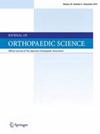Comparison of dynamic compression plate systems with oblique osteotomy and locking plate fixation versus transverse osteotomy and non-locking plate fixation for ulnar shortening osteotomy
IF 1.4
4区 医学
Q3 ORTHOPEDICS
引用次数: 0
Abstract
Background
Ulnar shortening osteotomy (USO) is a well-established surgical technique for ulnar impaction syndrome and triangular fibrocartilage complex injuries, but complications like delayed union and nonunion are often encountered. Transverse and oblique osteotomy techniques are commonly used, yet direct comparisons using advanced implants are limited. This study aims to compare the clinical and radiological outcomes of USO using the Jplate with a transverse osteotomy device and the APTUS Wrist Ulna Shortening System 2.5 with an oblique osteotomy device.
Methods
We retrospectively reviewed 37 patients who underwent USO (15 and 22 treated with the Jplate and APTUS systems, respectively) from July 2009 to October 2022. Clinical outcomes were measured using the visual analog scale (VAS), grip strength, range of motion, Quick Disabilities of the Arm, Shoulder, and Hand questionnaire, and Hand20 scores. Radiological outcomes included time to bone union, delayed union, and nonunion rates. Statistical analyses involved Mann-Whitney and Kruskal-Wallis tests and multivariable linear regression models adjusted for age, sex, and smoking status.
Results
Time to union was faster in the APTUS group compared to the Jplate group, with a significantly higher delayed union rate in the Jplate group than in the APTUS group. Postoperative pain reduction was significantly greater in the APTUS group compared to the Jplate group. Improvements in Hand20 scores were also significantly higher in the APTUS group compared to the Jplate group. Multivariable regression analyses confirmed that the APTUS system significantly shortened time to union and improved VAS and Hand20 scores.
Conclusions
The APTUS system provides superior clinical and radiological outcomes compared to the Jplate, with significant reductions in delayed union rates and postoperative pain and earlier bone healing. This system enables oblique osteotomy and compression of the osteotomy site with a single device, which may have contributed to the observed differences in our study.
Level of evidence
Level 4.
动态加压钢板系统斜截骨和锁定钢板固定与横向截骨和非锁定钢板固定用于尺侧缩短截骨的比较。
背景:尺侧短截骨术(USO)是治疗尺侧嵌塞综合征和三角形纤维软骨复合损伤的一种成熟的手术技术,但经常会遇到延迟愈合和不愈合等并发症。通常使用横向和斜向截骨技术,但使用先进的植入物进行直接比较是有限的。本研究旨在比较Jplate联合横截骨装置和APTUS腕尺缩短系统2.5联合斜截骨装置治疗USO的临床和影像学结果。方法:我们回顾性分析了2009年7月至2022年10月期间接受USO治疗的37例患者(分别采用Jplate和APTUS系统治疗的15例和22例)。临床结果采用视觉模拟量表(VAS)、握力、活动范围、手臂、肩膀和手的快速残疾问卷以及Hand20评分进行测量。放射学结果包括骨愈合时间、延迟愈合和骨不愈合率。统计分析包括Mann-Whitney和Kruskal-Wallis检验,以及调整了年龄、性别和吸烟状况的多变量线性回归模型。结果:与Jplate组相比,APTUS组愈合时间更快,Jplate组延迟愈合率明显高于APTUS组。与Jplate组相比,APTUS组术后疼痛减轻明显更大。与Jplate组相比,APTUS组在Hand20得分上的改善也明显更高。多变量回归分析证实,APTUS系统显著缩短了合并时间,提高了VAS和Hand20评分。结论:与Jplate相比,APTUS系统提供了更好的临床和放射学结果,显著降低了延迟愈合率、术后疼痛和早期骨愈合。该系统可以实现斜向截骨和单一装置对截骨部位的压迫,这可能是我们研究中观察到的差异的原因。证据等级:四级。
本文章由计算机程序翻译,如有差异,请以英文原文为准。
求助全文
约1分钟内获得全文
求助全文
来源期刊

Journal of Orthopaedic Science
医学-整形外科
CiteScore
3.00
自引率
0.00%
发文量
290
审稿时长
90 days
期刊介绍:
The Journal of Orthopaedic Science is the official peer-reviewed journal of the Japanese Orthopaedic Association. The journal publishes the latest researches and topical debates in all fields of clinical and experimental orthopaedics, including musculoskeletal medicine, sports medicine, locomotive syndrome, trauma, paediatrics, oncology and biomaterials, as well as basic researches.
 求助内容:
求助内容: 应助结果提醒方式:
应助结果提醒方式:


